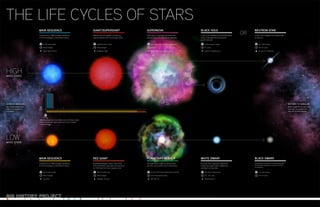
Star lifecycles poster
- 1. High-mass stars live for one million to tens of millions of years while low-mass stars, like our Sun, live for tens of millions to trillions of years. MASS TIME Composition is > 98% hydrogen and helium. 1/3 of the hydrogen is converted to helium. MAIN SEQUENCE Massive stars are capable of producing heavier elements, like iron, through fusion. GIANT/SUPERGIANT Outer layers of hydrogen and helium are ejected along with some heavier elements. SUPERNOVA A star's core collapses into extremely dense matter. Even light cannot escape the gravitational pull. BLACK HOLE A star's core collapses into a dense mass of neutrons. NEUTRON STAR Composition is > 98% hydrogen and helium. 1/3 of the hydrogen is converted to helium. MAIN SEQUENCE Expending hydrogen in their cores, these stars extend their outer layers and can grow to > 100 times their main sequence size. RED GIANT The outer layers of gas are ejected while the star's core contracts into a white dwarf. PLANETARY NEBULA This star core is typically composed of carbon and oxygen. Neon, magnesium, and helium are possible. WHITE DWARF A hypothetical remnant of a cooled white dwarf, the Universe's existence is too short to prove its existence. BLACK DWARF 10–150 solar masses 90% of lifespan Spica, Theta Orionis C significant loss of mass 10% of lifespan Betelgeuse, Rigel All but 10% of the original mass is ejected seconds Cassiopeia A, Kepler's Supernova 3 solar masses or larger 1070 years Cygnus X-1, Sagittarius A 1.4–3 solar masses 1033 –1045 years Circinus X-1, The Mouse .08–10 solar masses 90% of lifespan Sun, Altair 99% of original mass 10% of lifespan Aldebaran, Arcturus All but 5-15 % of the original mass is ejected tens of thousands of years M27, NGC 40 5%–15% of original mass 1015 - 1025 years Mira B, Sirius B < 1.4 solar masses 1033 –1045 years HIGHMASS STARS OR LOWMASS STARS BORN IN NEBULAE Gas clouds collapse and matter accumulates on a protostar. RETURN TO NEBULAE Matter expelled from stars can eventually accumulate into new star-forming nebulae. THE LIFE CYCLES OF STARS